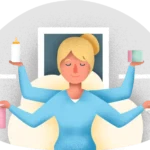Post-traumatic stress disorder, or PTSD, is a mental health condition triggered by experiencing or witnessing a traumatic event. Symptoms may include flashbacks, nightmares, severe anxiety, and uncontrollable thoughts about the incident. Living with these symptoms affects daily life, making it difficult to function as you once did. Here are some coping mechanisms and support systems for living with PTSD:
Talk Therapy
Psychotherapy, often called talk therapy, is a common approach for addressing PTSD. A therapist provides a confidential space where you can safely discuss your experiences and feelings. A therapist can also teach stress management techniques, mindfulness skills, and positive coping behaviors. Multiple types of talk therapy are used to support people with PTSD, including:
- Cognitive Processing Therapy: CPT is a structured, 12-session treatment that helps you examine and reshape unhelpful beliefs related to your trauma. Someone struggling with guilt after a traumatic experience might use CPT techniques to challenge and reframe their perceptions and find self-acceptance.
- Prolonged Exposure: PE therapy works by helping you gradually confront trauma-related memories, feelings, and situations rather than avoiding them. Guided exposure may begin with imagining the event or writing about it, and over time, lead to facing triggers in real life. Through this approach, anxiety may lessen, and reminders of the trauma become less distressing.
- Eye Movement Desensitization and Reprocessing: EMDR involves following a therapist’s cues, such as hand movements or tapping, while recalling distressing memories. The movements appear to help the brain process memories differently, making them feel less overwhelming.
PTSD Medications
Certain medications may be prescribed to help manage PTSD symptoms and support daily functioning. Antidepressants can be used to address persistent symptoms such as sadness, irritability, worry, anger, and emotional numbness. Some medications work by influencing chemical messengers in the brain that are linked to mood and stress responses. Other medications, such as those designed for sleep, may be helpful when nightmares or insomnia disrupt rest and recovery.
Your healthcare provider will work with you to develop a safe and effective plan tailored to your specific symptoms. Regular check-ins allow for medication adjustments, monitoring of side effects, and discussions about your overall progress. Medication is often used together with therapy as part of a balanced and ongoing treatment plan.
Stellate Ganglion Block
A Stellate Ganglion Block (SGB) is an interventional procedure sometimes used to treat PTSD symptoms. The stellate ganglion is a cluster of nerves located in the neck that is involved in the body’s fight-or-flight response, which is frequently overactive in individuals with PTSD. During an SGB procedure, a medical provider injects a local anesthetic into the area near these nerves. Precise imaging tools, such as ultrasound or fluoroscopy, guide the needle. The goal of the injection is to help calm the sympathetic nervous system and reduce heightened anxiety and fear reactions.
SGB is typically performed in a clinic or hospital setting and is completed relatively quickly. While SGB is not a standard therapy for everyone, some people find it helpful as part of a broader plan that includes counseling and medication. It can be viewed as a supplement to other established treatment approaches.
Find PTSD Relief Today
Managing PTSD involves finding the type of support and treatment that fits your individual needs and circumstances. Developing an approach that incorporates a mix of coping mechanisms enables you to create a plan tailored to your experience. Healthcare professionals help you navigate available therapies and find constructive strategies. Contact a healthcare provider today to learn more about SGB and other PTSD treatments.














